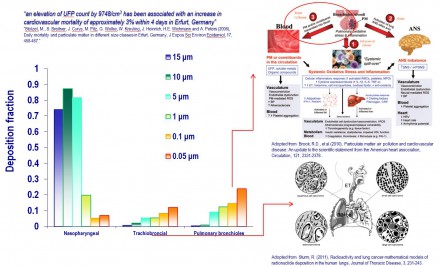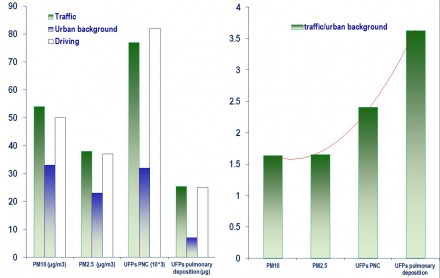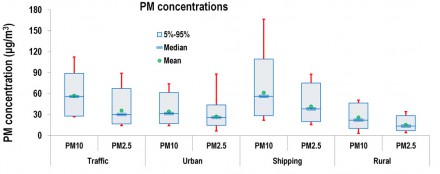The TRANSPHORM project
To enhance the methodology for HIA and to establish a robust link between exposure to PM and the mechanisms of several diseases, we need to incorporate several methodological steps. This includes
a) particle size distribution deposition across the depth of the human respiratory tract (HRT) – link to the endpoints of relevance and translation. PM of different diameters tend to deposit at different depths across the respiratory tract, with the smaller diameter particles (especially Ultra Fine Particles –UFPs-) to deposit at the lowest part (alveoli), being subjected to translocation to the systemic circulation (Figure 1).
b) particokinetics of UFPs translocated within the systemic circulation and estimation of biologically effective dose reaching the target tissue (e.g , always with respect to the mechanism of action)
Figure 1. PM size segregated HRT deposition.
c) internal dose of toxicants adsorbed in the particles (e.g. PAHs) and toxicokinetic fate upon entrance to the systemic circulation. Incorporation of internal dose in health risk estimates, requires also the incorporation of time-activity patterns, being in total a more individual oriented method, enhancing the framework of the full chain analyses. While being challenging, because to apply results at a European level would be data-intensive, and we anticipate important gaps in data (mostly) and evidence, we consider this to be an important step forward.
Figure 2. Investigating non-linearity among different PM exposure metrics.
In the frame of TRANSPHORM, a PM source apportionment study is currently ongoing with parallel measurements in Thessaloniki and Rotterdam. PM10 and PM2.5 are measured simultaneously at three urban (traffic, urban background and shipping) and one rural site. Beyond gravimetric analysis, chemical analysis includes PAHs, heavy metals and ions, as well as assessment of PM toxicity through oxidative potential (Reactive Oxygen Species analysis). Mass concentration results up to now are illustrated in Figure 3.
Figure 3. PM10 and PM2.5 concentrations (mean-max-min values) for all cites.






